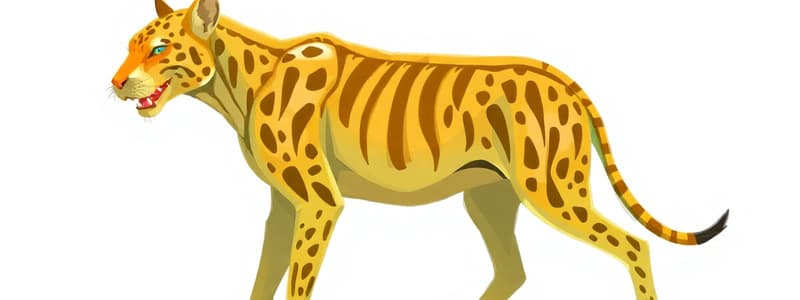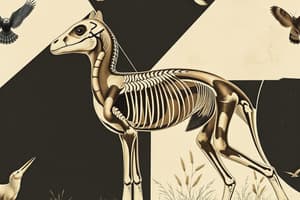Podcast
Questions and Answers
Larva is found in which group of animals?
Larva is found in which group of animals?
- Only Vertebrates
- Only Mammals
- Both Vertebrates and Invertebrates (correct)
- Only Invertebrates
Which term describes animals that cannot regulate their body temperature internally?
Which term describes animals that cannot regulate their body temperature internally?
- Endotherms
- Isotherms
- Facultative
- Ectotherms (correct)
What is the primary characteristic of animals with bilateral symmetry?
What is the primary characteristic of animals with bilateral symmetry?
- Asymmetrical body structure
- Identical halves in multiple planes
- Identical halves in only one plane (correct)
- Symmetrical around a central axis
In which group of organisms does trochophore larva typically occur?
In which group of organisms does trochophore larva typically occur?
Which type of organism possesses radial symmetry?
Which type of organism possesses radial symmetry?
What type of body plan is shown by organisms in the phylum Coelenterata?
What type of body plan is shown by organisms in the phylum Coelenterata?
An animal that is active during the night is referred to as what?
An animal that is active during the night is referred to as what?
Which type of symmetry allows equal body organization around a central point?
Which type of symmetry allows equal body organization around a central point?
Which statement about the phylum Echinodermata is false?
Which statement about the phylum Echinodermata is false?
Which characteristic is associated with deuterostome development?
Which characteristic is associated with deuterostome development?
Flashcards
Larva in Invertebrates
Larva in Invertebrates
Larva is an immature form of an invertebrate; this stage of development often differs significantly from the adult form.
Poikilotherms
Poikilotherms
Animals whose body temperature varies with the environment; also called ectotherms.
Plankton
Plankton
Organisms that float on or near the surface of water; classified as drift.
Bilateral Symmetry
Bilateral Symmetry
Signup and view all the flashcards
Radial Symmetry
Radial Symmetry
Signup and view all the flashcards
Coelomates
Coelomates
Signup and view all the flashcards
Trochophore Larva
Trochophore Larva
Signup and view all the flashcards
Nocturnal Animal
Nocturnal Animal
Signup and view all the flashcards
Parasites Obligate
Parasites Obligate
Signup and view all the flashcards
Enterocoelous Coelom
Enterocoelous Coelom
Signup and view all the flashcards
Study Notes
Animal Classification and Important Terms
- Larva: Found in both vertebrates and invertebrates.
- Poikilotherms: Also known as ectotherms.
- Plankton: Animals/organisms floating on the water surface.
- Radial symmetry: Body can be divided into identical halves in only one plane.
- Asymmetry: Organisms attached to substrata generally possess asymmetric bodies.
Animal Characteristics
- Non-chordates: Lack a notochord, dorsal tubular nerve chord, pharyngeal gill slits and hepatic portal system.
- Cell aggregate plan: Found in Cnidarians.
- Deuterostomes: Spiral cleavage, blastopore becoming the mouth.
- Protostomes: Mouth develops first during embryonic development.
- Ectotherms: Cold-blooded animals.
- Endotherms: Warm-blooded animals.
Animal Body Plans
- Tube-within-a-tube body plan: Found in Coelenterates, Platyhelminthes, Aschelminthes (Nemethelminthes), and Porifers.
- Blind sac body plan: Found in roundworms.
- Coelomate: Food diffuses from gut to tissues by coelomic fluid.
Other Key Facts
- Important terms:
- Enterocoelous coelom: Found in deuterostomia.
- Facultative parasites: Live without a host.
- Nocturnal animals: Active at night.
- Diurnal animals: Active during the day.
- Radial symmetry: Fishes, Star fishes, Molluscs,Sponges.
- Common characteristics
- Earthworm: Hermaphrodite, smaller male.
- Echinoderms: Protostomatous coelomates.
- Human teeth: Anatomically comparable to shark scales.
- Hair: A skin derivative.
- Enterozoa: Includes Annelida, Mollusca, Porifera, Echinodermata, Hemichordata.
- Cold-blooded/warm-blooded animals: Ectotherms/Endotherms.
- Psychrotherms
- Thermophiles
Studying That Suits You
Use AI to generate personalized quizzes and flashcards to suit your learning preferences.




